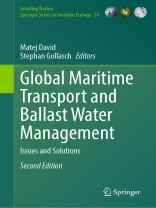In 2015 the first edition of this book was published before the Ballast Water Management (BWM) Convention entered into force. To our knowledge this was and still is the first comprehensive book on BWM worldwide. It provided an overview of possible solutions to the complex issue of BWM. It further outlined consequences and implications to address the ballast water ‘problem’ in line with provisions of the BWM Convention considering environmental, shipping, legal and policy perspectives.
The previously addressed subjects remain essential, but new subjects appeared which more recently have proven to be critical for the effective BWM Convention implementation. After the first book content was already agreed and in preparation, new advances were achieved in BWM-related research around the world. Further, new experience was gained and issues came out during the preparation processes of countries for the BWM Convention implementation. The editors of the first book remained heavily involved in BWM-related research and other processes, hence these new critical BWM issues and subjects are now dealt with in the second edition of this book to complement the first one.
In essence, this new book covers main issues that arose recently during the implementation of the BWM Convention. Scientists and experts with extensive experience in these subjects from around the globe from academic and private sectors, as well as national administrations, were involved in the preparation of this book.
Daftar Isi
Introduction – Update Of Bwm Book 1st Edition.- Type Approval Tests Of Ballast Water Management Systems, What Have We Learned In >10 Years Testing.- Testing Ballast Water Management Systems – Challenge Water Conditions During More Than 100 Test Voyages.- Ballast Water Discharges And Safety Aspects Of Using Active Substances For Ballast Water Treatment.- Compliance Monitoring And Enforcement Of The Bwm Convention – The Port State Control Perspective.- Ballast Water Sampling For Compliance Monitoring And Enforcement Of The Bwm Convention – D-1 And D-2 Indicative Tests.- Ballast Water Management Options In Ports.- Ballast Tank Sediment – A Neglected Subject Which Requires Management.- Databases To Support Different Ballast Water Management Tools.- Five Years Of “Lively” Implementation Of The Bwm Convention – Global Guidance, Regional Challenges And National Issues.- Overall Conclusions On The Ballast Water Issue And Its Management Options.
Tentang Penulis
Dr. Matej David is full professor in maritime studies with more than 20 years of research in the field of ballast water issue and its management. For several years he participated in the work of IMO Marine Environment Protection Committee and European Maritime Safety Agency, including conducting trainings for Port State Control and other institutions responsible for the implementation of the BWM Convention. Nowadays he runs his private company, for more than 15 years conducts shipboard tests of BWM systems worldwide, prepares dossiers for Basic and Final Approvals, conducts tests of Compliance Monitoring Devices, and continues research activities in the field of the BWM and environmental issues in shipping/maritime transport.
Dr. Stephan Gollasch works with ballast water since 1992 when he began his Ph D on sampling biology from ballast water of ocean-going vessels, which was the first study of this kind conducted in Europe. During this study he also became an advisor for ballast water issues and member of the German Delegation at committees and sub-committees of IMO. Nowadays he works as consultant, located in Hamburg, Germany – the busiest German port. The services he provides are related to marine research and technology developments. This especially includes work on biological invasions, ship sampling, port State control Compliance Monitoring Devices and shipboard tests of ballast water management systems.












